Wetenschappers zien Waddenzee ernstig bedreigd door klimaatverandering
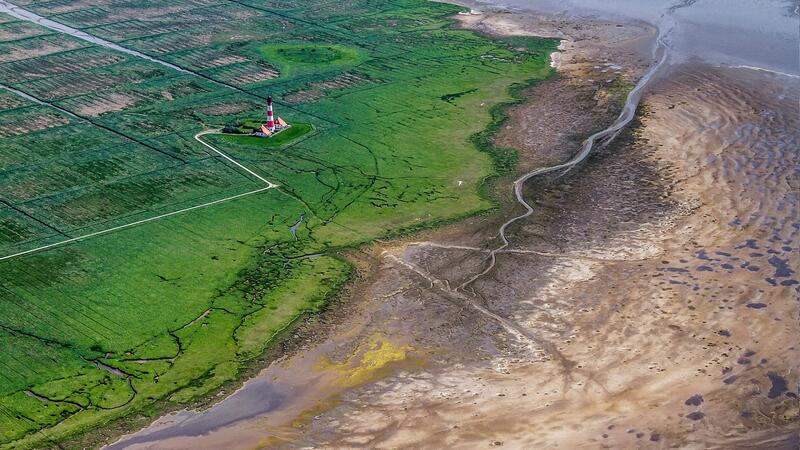
Van 30 november t/m 2 december 2021 presenteerden en discussieerden ruim 200 wetenschappers uit Denemarken, Duitsland en Nederland tijdens het 15e International Scientific Wadden Sea Symposium (ISWSS) over de nieuwste wetenschappelijke bevindingen rondom het UNESCO Werelderfgoed Waddenzee. De conferentie was oorspronkelijk gepland als een fysieke bijeenkomst in Büsum, Duitsland, maar vond nu online plaats.
Klimaatverandering en de daarmee samenhangende zeespiegelstijging worden beschouwd als de grootste bedreigingen voor het wereldwijd unieke ecosysteem van de Waddenzee. De effecten hiervan op de biodiversiteit en de geologische dynamiek van de Waddenzee stonden centraal tijdens het symposium, evenals mogelijke beschermende maatregelen.
Zes onderwerpen en de invloed van klimaatverandering hierop werden in afzonderlijke sessies behandeld: vogels, zeezoogdieren, invasieve soorten, sublitorale leefgebieden en ecologische duurzame ontwikkeling. Voor elk onderwerp werden de nieuwste onderzoeksresultaten gepresenteerd. Daarnaast werden in de expertgroepen, per onderwerp, aanbevelingen voor het beheer van de Waddenzee besproken en verder noodzakelijk onderzoek geformuleerd.
"Continu hoge aantallen nieuwe soorten in de Waddenzee en hun succesvolle vestiging laten zien hoe menselijke factoren elkaar kunnen beïnvloeden", aldus Dr. Christian Buschbaum, mariene ecoloog bij het Alfred Wegener Instituut op het eiland Sylt, die de sessie over neobiota leidde. “Met de wereldwijde scheepvaart worden uitheemse soorten ingevoerd. Door de opwarming van het klimaat vinden ze goede leefomstandigheden in de Waddenzee. Welke effecten deze exoten op het ecosysteem hebben staat centraal in het onderzoek. Het ontwikkelen van maatregelen om de Waddenzee tegen verdere introductie en verspreiding van nieuwe soorten te beschermen is een steeds belangrijker wordende internationale taak.”
Het symposium keek daarnaast voorbij de grenzen van het eigen beschermde gebied. Zo kwamen ook internationale Werelderfgoed experts en gastsprekers uit het Koreaanse Waddengebied Getbol aan het woord, een gebied dat sinds deze zomer op de lijst van Werelderfgoederen staat.
Aan het einde van de driedaagse bijeenkomst vatte de voorzitter van de Wadden Sea Board, het hoogste bestuursorgaan van de Trilaterale Waddenzee Samenwerking, de bevindingen van het symposium samen: “De wetenschap toont aan dat het Werelderfgoed Waddenzee al aanzienlijk beïnvloed wordt door de gevolgen van klimaatverandering. Het symposium benadrukte vooral de noodzaak om de uitwisseling van gegevens en informatie tussen de drie landen verder te intensiveren, om het beheer voor de bescherming van de Waddenzee aan te kunnen passen aan nieuwe uitdagingen,” aldus prof. dr. Karin Lochte. “Ik ben erg dankbaar voor de goede internationale samenwerking, die het mogelijk maakt om de grote uitdagingen voor bescherming en beheer van dit kwetsbare ecosysteem aan te pakken.”
De resultaten van de wetenschappelijke discussies zullen de basis vormen voor de Ministeriële Verklaring van de eerstvolgende Trilaterale Regeringsconferentie van de drie Waddenzeelanden. Deze conferentie zal eind 2022 in Wilhelmshaven op uitnodiging van Duitsland plaatsvinden, en vormt tevens het einde van het Duitse periodieke voorzitterschap van de Trilaterale Waddenzee Samenwerking. De Regeringsconferentie zet de politieke koers uit voor de bescherming van de Waddenzee in de komende jaren. De wetenschappelijke resultaten van het symposium zullen bovendien in het tijdschrift "Marine Biodiversity" worden gepubliceerd onder de titel “Biodiversity and Ecology of the Wadden Sea under changing environments".
“Met meer dan 200 internationale deelnemers was er veel animo voor het virtuele symposium. De collegiale uitwisseling werkte ook online uitstekend dankzij het multifunctionele platform”, aldus een enthousiaste Marina Sanns van het bestuursorgaan voor het Nationaal Park “Schleswig-Holsteinisches Wattenmeer”, die een belangrijke rol speelde bij de organisatie van het symposium. “Dit was een mooie afsluiting van ons Nationaal Park-themajaar “Wetenschap in de Waddenzee – het verborgene aan het licht brengen”.
Het 15e ISWSS werd georganiseerd door het bestuursorgaan van het Nationaal Park "Schleswig-Holsteinisches Wattenmeer" in samenwerking met het Duitse federale ministerie van Milieu en het Gemeenschappelijk Waddenzee Secretariaat (CWSS). Dit wetenschapssymposium vindt geregeld plaats in het kader van de Trilaterale Samenwerking voor de Bescherming van de Waddenzee, één jaar voor het einde van het periodieke presidentschap van een van de drie Waddenzeelanden. Het vorige symposium was in 2017 in Tønder, Denemarken.
>> Symposium Report
A visual take on ISWSS15
Science illustrator and researcher Jagoba Malumbres-Olarte listen in to the thematic sessions of the symposium. Below he explains his illustrations.
Overall illustration
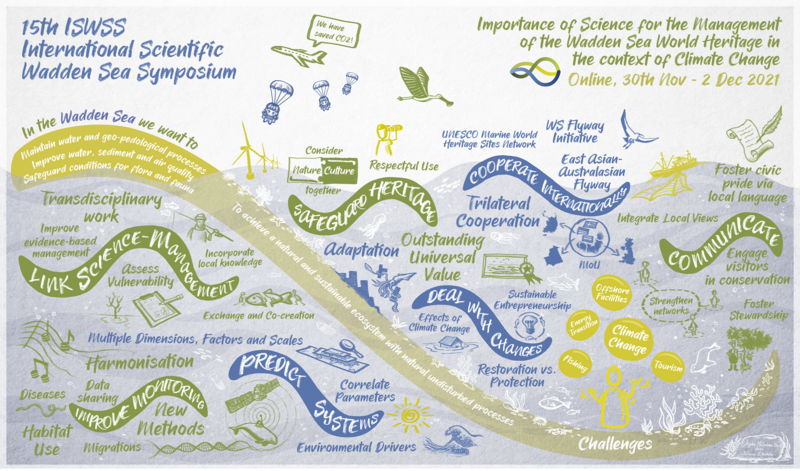 The overall illustration of the symposium highlights some of the main discussions as well as the general character of the event, starting with the fact that it had to be moved online at last minute - saving CO2 from the cancelled travel plans. With the Trilateral Wadden Sea Cooperation's Guiding Principle running through the image, its main challenges are shown in balls, needing to be juggled at the same time. Calls for action include safeguarding the Wadden Sea World Heritage, coorperating internationally, dealing with changes, linking science and management, improving monitoring, trying to predict the system and communicating the Wadden Sea.
The overall illustration of the symposium highlights some of the main discussions as well as the general character of the event, starting with the fact that it had to be moved online at last minute - saving CO2 from the cancelled travel plans. With the Trilateral Wadden Sea Cooperation's Guiding Principle running through the image, its main challenges are shown in balls, needing to be juggled at the same time. Calls for action include safeguarding the Wadden Sea World Heritage, coorperating internationally, dealing with changes, linking science and management, improving monitoring, trying to predict the system and communicating the Wadden Sea.
Alien Species
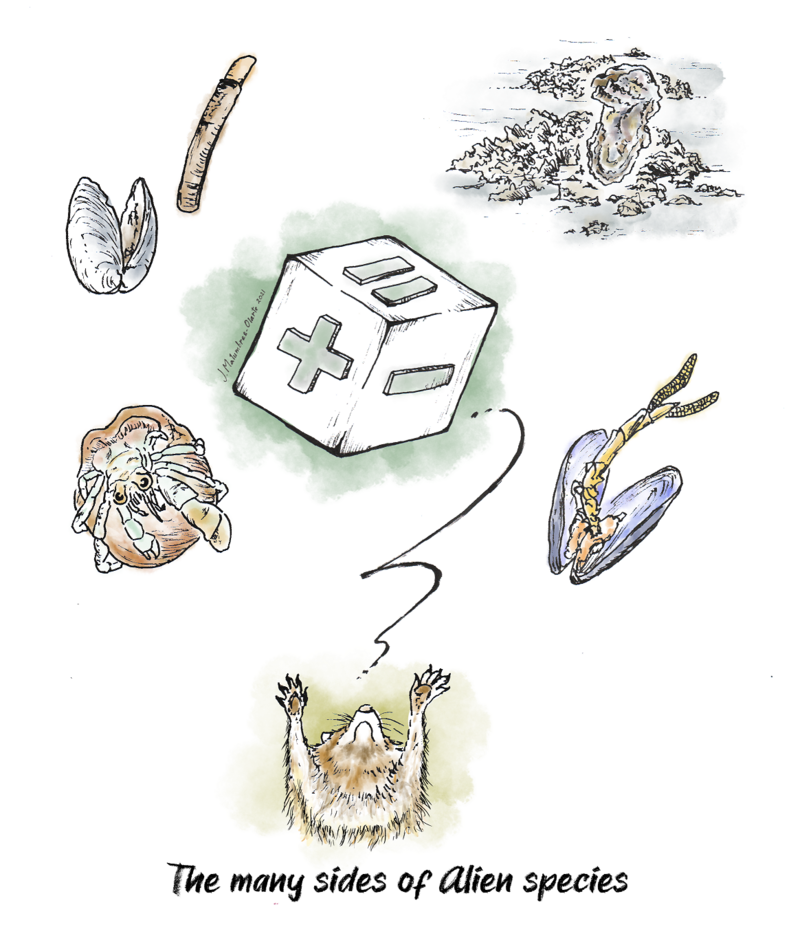 The image shown here symbolises the current debate about alien (exotic, non-native) species in the Wadden Sea: how alien species should be treated in the Wadden Sea. As discussed in the alien species session during the Symposium, these species may have positive, negative or no effects (shown on the different sides of the die) for local biodiversity and society: the saltwater clam Ruditapes phlippinarum and razor clam Ensis leei (top left); the habitat changing oyster Magallana gigas (top right); the intestinal copepod parasite of bivalves Mytilicola orientalis, (illustrated with a native blue mussel, bottom right); the hermit crab Diogenes pugilator (bottom left); and the racoon dog (bottom).
The image shown here symbolises the current debate about alien (exotic, non-native) species in the Wadden Sea: how alien species should be treated in the Wadden Sea. As discussed in the alien species session during the Symposium, these species may have positive, negative or no effects (shown on the different sides of the die) for local biodiversity and society: the saltwater clam Ruditapes phlippinarum and razor clam Ensis leei (top left); the habitat changing oyster Magallana gigas (top right); the intestinal copepod parasite of bivalves Mytilicola orientalis, (illustrated with a native blue mussel, bottom right); the hermit crab Diogenes pugilator (bottom left); and the racoon dog (bottom).
Marine Mammals
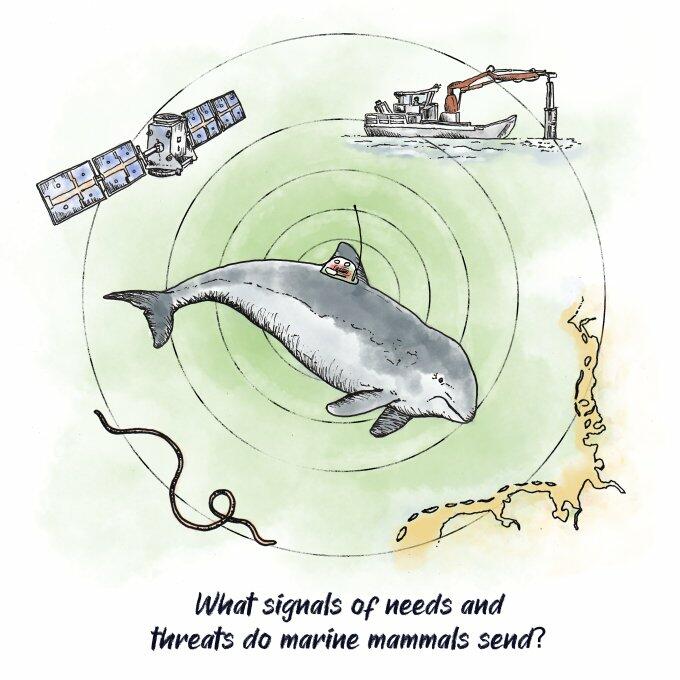 This image resumes the research subjects of the seminars presented in the marine mammal session of the Symposium: the species monitoring using telemetry; the (intertidal) habitats used and needed by the different species; the effects of anthropogenic activities (e.g. through noise); and the impact of diseases on the reproduction and population demographics. All these factors must be considered for the management of marine mammals in the Wadden Sea.
This image resumes the research subjects of the seminars presented in the marine mammal session of the Symposium: the species monitoring using telemetry; the (intertidal) habitats used and needed by the different species; the effects of anthropogenic activities (e.g. through noise); and the impact of diseases on the reproduction and population demographics. All these factors must be considered for the management of marine mammals in the Wadden Sea.
Birds
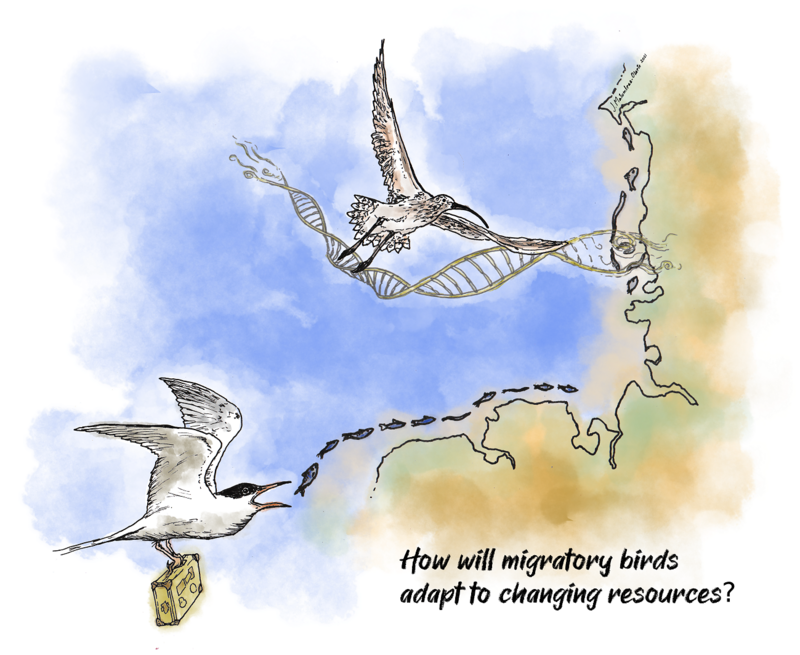 The birds in this image represent the migration through he Wadden Sea that may be determined by the resources available in the area (the tern with the suitcase and the fish-looking islands) and the genetic trigger in each species (Numenius arquata and the DNA helix).
The birds in this image represent the migration through he Wadden Sea that may be determined by the resources available in the area (the tern with the suitcase and the fish-looking islands) and the genetic trigger in each species (Numenius arquata and the DNA helix).
Sublittoral Habitats
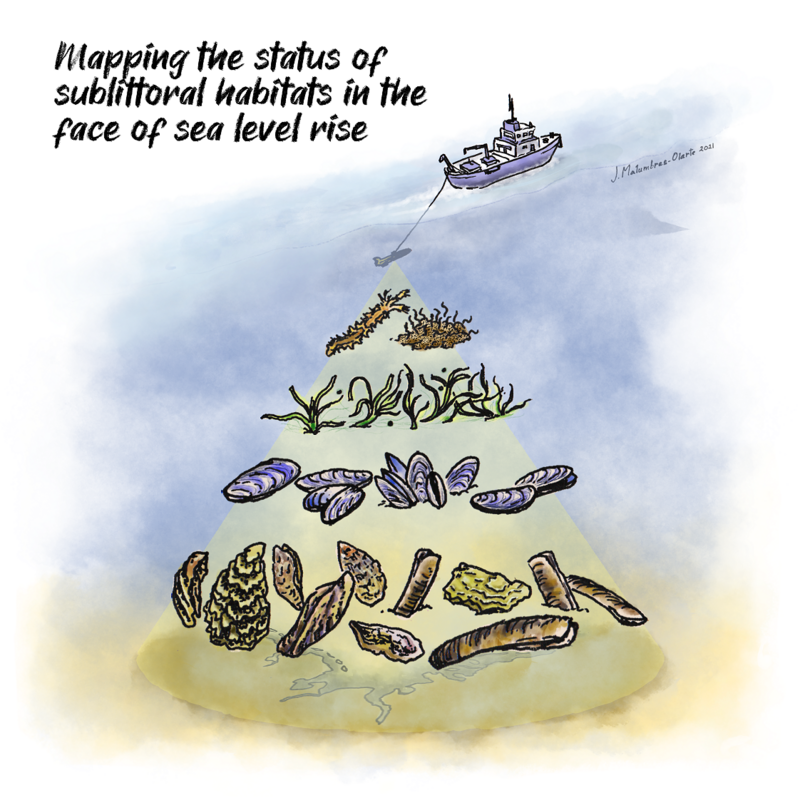 This image shows the mapping of sublittoral habitats by a research vessel using scan sonars and the four current features of/initiatives in these habitats in the Wadden Sea: the invasion of Ensis leei and Magallana gigas (bottom); the evaluation surveys on native Mytilus edulis musselbeds (second from the bottom); the restoration of Zostera seagrass (third from the bottom); and the decline of reef-forming Sabellaria spinulosa worms. The upwards direction of the sea represents the rise in the sea level.
This image shows the mapping of sublittoral habitats by a research vessel using scan sonars and the four current features of/initiatives in these habitats in the Wadden Sea: the invasion of Ensis leei and Magallana gigas (bottom); the evaluation surveys on native Mytilus edulis musselbeds (second from the bottom); the restoration of Zostera seagrass (third from the bottom); and the decline of reef-forming Sabellaria spinulosa worms. The upwards direction of the sea represents the rise in the sea level.
Sustainable Development - Ecology
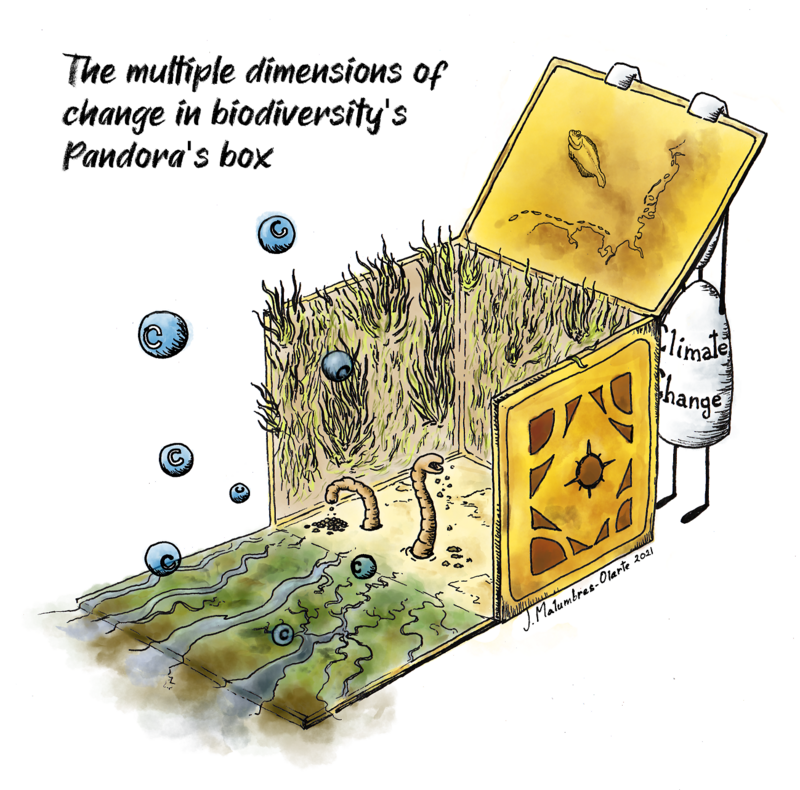 The image shows the “Pandora’s Box” of the measurement of biodiversity change (in multiple dimensions), which could assist us understand the drivers behind it, necessary for ecosystem status assessments in the face of climate change. These measurements and assessments may show how the recovery of seegrass habitats may be achieved and what effects climate change may have on the carbon sequestrated in salt marshes. The worms represent the effects of bioturbation on sediments (not fully understand) and the map of the Wadden Sea on the side of the box is a hint on the effects of climate change on the phenology (migration patterns) of certain species like the plaice.
The image shows the “Pandora’s Box” of the measurement of biodiversity change (in multiple dimensions), which could assist us understand the drivers behind it, necessary for ecosystem status assessments in the face of climate change. These measurements and assessments may show how the recovery of seegrass habitats may be achieved and what effects climate change may have on the carbon sequestrated in salt marshes. The worms represent the effects of bioturbation on sediments (not fully understand) and the map of the Wadden Sea on the side of the box is a hint on the effects of climate change on the phenology (migration patterns) of certain species like the plaice.
Sustainable Development - Social-Cultural
 The sphere in this image is based on the classic ying-yang symbol and represents the dichotomy between nature (left) and culture-society (right). This separation is not often (and should not be) clear, like in the case of the tourists that enjoy nature (bottom left). Also, the locals (top right) usually develop a mixture motion of both (by seeing them as part of the same landscape) and a sense of stewardship (hence her/his holding the tree). The book and the flying pages represent the role of literature in understanding and achieving sustainable development. The sunken church tower represents the flooded towns in Frisian marshands and the interactions between nature and human landscapes.
The sphere in this image is based on the classic ying-yang symbol and represents the dichotomy between nature (left) and culture-society (right). This separation is not often (and should not be) clear, like in the case of the tourists that enjoy nature (bottom left). Also, the locals (top right) usually develop a mixture motion of both (by seeing them as part of the same landscape) and a sense of stewardship (hence her/his holding the tree). The book and the flying pages represent the role of literature in understanding and achieving sustainable development. The sunken church tower represents the flooded towns in Frisian marshands and the interactions between nature and human landscapes.
International Perspectives
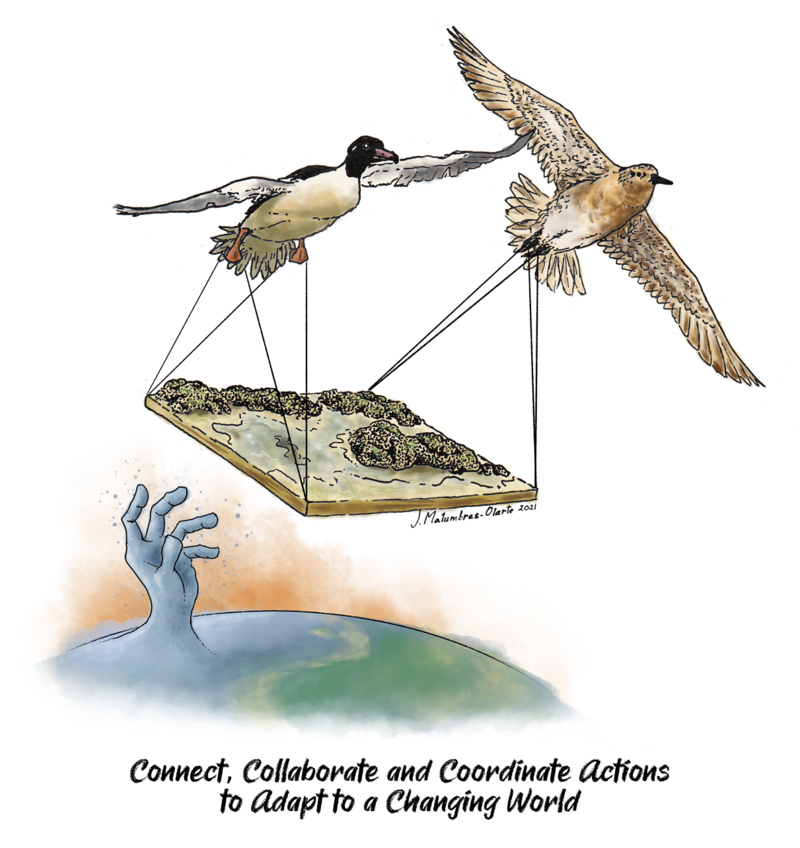 The two birds (Calidris canutus and Mergus squamatus) represent, at the same time, two migratory flyways (East Atlantic and Australasian, respectively) and the research and management groups that work in different parts of the world. These groups (the birds) may collaborate with each other (sharing knowledge, experience, assessment tools and actions) to develop better sustainable development strategies, and to better protect and manage coastal habitats and the related heritage. These actions may include the restoration of coastal habitats (represented in the illustration by reefs formed by Sabellaria spinulosa worms), as a strategy to adapt to climate change (represented by the orange dawn) and the rise of the sea level (represented by the rising hand).
The two birds (Calidris canutus and Mergus squamatus) represent, at the same time, two migratory flyways (East Atlantic and Australasian, respectively) and the research and management groups that work in different parts of the world. These groups (the birds) may collaborate with each other (sharing knowledge, experience, assessment tools and actions) to develop better sustainable development strategies, and to better protect and manage coastal habitats and the related heritage. These actions may include the restoration of coastal habitats (represented in the illustration by reefs formed by Sabellaria spinulosa worms), as a strategy to adapt to climate change (represented by the orange dawn) and the rise of the sea level (represented by the rising hand).
